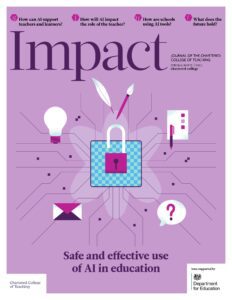Harnessing artificial intelligence to transform CPD and reduce educator workload in sixth-form colleges

DAVID J WALL, HEAD OF VISUAL AND PERFORMING ARTS/TLA DEVELOPER, ST JOHN RIGBY COLLEGE, UK
In the fast-paced and demanding environment of an Ofsted-outstanding sixth-form college, educators face increasing pressure to balance high-quality teaching with administrative duties. The integration of artificial intelligence (AI) presents a promising solution to alleviate these burdens, enabling educators to focus on their core role of facilitating student learning. This article explores the transformative impact of AI in reducing workload for teaching and support staff, focusing on its application in continuing professional development (CPD) sessions. Drawing on two years of practical experience and key research insights, this case study demonstrates how AI can be leveraged to reduce workload while maintaining educational excellence.
Context and aims
The implementation of AI in CPD was driven by the aim of enhancing teaching quality and improving teacher wellbeing. The NASUWT (2024), in their ‘Wellbeing survey briefing’, revealed that ‘54% of teachers say that workload… has been the main factor for increased work-related stress’ (p. 1). The NEU (2024) found in a survey of over 8,000 NEU members that ‘two in five (41%) describe their workload as “unmanageable,” and for a further 37% “only just manageable”’. The objective of the AI-focused CPD initiative was to introduce practical, accessible tools that could:
- reduce time spent on routine tasks
- enhance the quality of teaching
- foster a culture of experimentation and collaboration.
In the Department for Education’s report ‘Generative AI in education’ (Open Innovation Team and DfEDepartment for Education - a ministerial department responsible for children’s services and education in England, 2024), it was found that ‘teachers and experts acknowledge that GenAI could have a transformative impact on education. From helping teachers save time by automating tasks, to improving teaching effectiveness by personalising learning for students.’ (p. 4) The Education Endowment Foundation (Baxter, 2024) published a report claiming that ‘teachers using ChatGPT, alongside a guide to support them to use it effectively, can reduce their lesson planning time by 31 per cent’. This, along with my own workload and a lack of ‘joy’ in some of my teaching, led me to think about how to move forwards with new technologies.
CPD session overview
Over two years, I have delivered several CPD sessions on technology (SharePoint, OneDrive, MS Teams) and AI. A recent CPD session, designed using AI tools, in which I used very specific prompts, showcased how tools like ChatGPT, Microsoft Copilot and Prezi could be integrated into daily teaching practice. The session was created using very specific prompts in AI and then adapted to cover:
- Automating lesson planning: Teachers explored how ChatGPT could generate detailed lesson plans, adaptive teaching activities, practical activities and extension tasks in under 10 minutes. For example, a prompt asking for a lesson plan on Stanislavsky’s acting methods produced a detailed structure, complete with key discussion points, suggested activities and assessment questions.
- Creating rubrics and model answers: AI tools were demonstrated to produce clear, standards-aligned rubrics for assessments. Staff saw how these tools could generate high-quality model answers tailored to different levels, which not only saved time but also supported consistent marking.
- Developing lesson presentations: Using Prezi, teachers created visually engaging and interactive presentations in minutes. By entering a lesson’s objectives and key words, AI could produce an editable presentation, significantly reducing preparation time.
- Streamlining administrative tasks: Staff were introduced to Microsoft Copilot, which automated tasks such as drafting letters to parents, replying to emails and creating risk assessments. For example, a risk assessment template was completed in under five minutes with minimal manual input.
Staff were able to use modelled examples in their own way by using computers in the CPD session, which allowed for easier ‘buy-in’, as they could see the AI tools working there and then. Models and prompts, which I had been developing over two years to create my own resources, were provided to staff.
Application in practice
After gleaning information from seminal texts such as Winnick’s The Generative Age (2023), Clark’s The AI Infused Classroom (2023) and Meyersieck’s AI in Education (2023), I decided to undertake some uses of AI myself and to begin to design prompts and materials that would be useful in teaching, learning and assessment, but also in day-to-day teacher life.
We began with scheme of work automation, looking at BTEC units for the BTEC National Extended Certificate in Performance. I was able to show that by using the exam board specification, it is possible to map the skills and activities needed for the unit being covered. Produced as a table, it was broken down into week and lesson number, teacher and student activities, assessment, specification links and resources needed. I was then able to show staff how to copy a lesson from the scheme of work back to ChatGPT to produce the detailed lesson plan and the resources, such as worksheets, quizzes, assessment sheets and so on. I was able to show staff how ChatGPT can even produce a lesson script for those issues that staff may not be sure about how to deliver – this was done for a lesson on Stanislavsky’s acting techniques and for demonstrating how the Alexander Technique is used in an actor’s preparation.
I was able to show demonstrations of worksheets, such as a handout on camera angles for film and TV, and how ChatGPT had produced a short film script for students to practise the camera angles, giving details on which angle to use at which stage. This was tailored to the actors in the class.
Another good demonstration was the use of ChatGPT and Microsoft Copilot to remove administrative and research tasks, such as finding examples of playscripts to use with the specific class that I teach and to produce a tailored risk assessment for a trip. I even produced an agenda for a faculty meeting to show how ChatGPT/Copilot can be used to assist as a middle leader.
Prezi is a new addition to my AI toolbox this year. I had used Prezi many years ago, when I was training as a teacher, but found that they had now added an AI feature. I demonstrated how, by adding key words, AI prompts, specification information, topics, etc., Prezi will produce an editable presentation that is visually pleasing but also contains the content for a lesson. At £4 per month, this is saving me so much time in producing lesson presentations and including very good content. This has been especially helpful where the output needed is mainly factual. These facts are included (while, of course, being checked and sometimes adapted), for example, within presentations on the periods of music for A-level music sessions.
Prompt examples
Scheme of work planning
Generate a three-week A-level scheme of work for students aged 16–18 as a table. The table should have columns for ‘week number’, ‘lesson number’, ‘objectives’, ‘teacher activities’, ‘learner activities’, ‘assessment’, ‘timing’ and ‘assessment objectives’. Each week should have three lessons in a sequence of one lesson of 100 minutes, one lesson of 75 minutes and one lesson of 100 minutes.
Here are the assessment objectives of the scheme of work: Learners must present a detailed and comprehensive account, showing a thorough and informed understanding of the role of the professional performer. They should evaluate the various technical, practical, employability and personal skills required, and how the performer may secure employment and achieve longevity through effective skills and professional development. Learners will evaluate training and qualification routes in terms of their appropriateness and viability, and their work will draw conclusions about the impact of working patterns and lifestyle factors on the performer’s career. Learners’ conclusions will be well argued and supported by well-chosen examples. Their work will be presented to a high standard, with effective use of subject-specific terminology, relevant presentation techniques – for example, practical demonstrations – and good use of grammar.
Include the exact assessment objectives I provided in the assessment objectives column for each corresponding part of the lesson. In the timing column, include the amount of time that should be spent on that part of the lesson.
Lesson planning
Here is a set of prompts that I used within a ChatGPT conversation to create the lesson plan and the resources needed:
- You are delivering sessions to 16- to 18-year-old BTEC acting students. The session is 100 minutes long. They are studying Unit 17 Screen Acting from the BTEC Level 3 National Extended Certificate in Performance. The students are doing skills-building workshops and need to complete a practical project through the 100-minute session. The students need to cover skills for realistic film acting. You must put together a task sheet for the students to follow for a 100-minute session.
- Can you create a handout with the key skills and techniques needed for realistic screen acting?
- Can you create a plotline and storyboard idea for a realistic film exercise?
Challenges and considerations
While the benefits of AI are clear, its integration is not without challenges:
- Initial learning curve: Some staff found the tools intimidating initially, necessitating additional training and support.
- Ethical concerns: Ensuring that AI outputs are accurate, unbiased and aligned with curriculum standards requires vigilance. AI is not completely accurate and should always be checked. One must also be sure to check the bias that AI has encountered and that the output fits what is needed. AI picks up on various curriculums and standards – these need to be checked with exam boards, school curriculums, National Curriculum, etc., to ensure that what is created is fit for purpose.
- Access and equity: Not all educators have access to high-quality AI tools, which could exacerbate existing disparities in resources.
Practical recommendations
For institutions looking to replicate this approach, the following steps are recommended:
- Start small: Introduce one or two AI tools in targeted CPD sessions, focusing on their most impactful applications.
- Provide ongoing support: Offer follow-up workshops, drop-in sessions and a shared resource hub to support staff. In our case, this was a SharePoint page and an MS Teams channel, which we share for those who are interested.
- Encourage experimentation: Foster a culture where staff feel comfortable experimenting with AI tools and sharing their experiences. This is important for both the things that went well and those that didn’t go as well.
- Evaluate impact: Use staff surveys and workload audits to measure the tangible benefits of AI integration and refine the approach as needed.
Conclusion
The integration of AI into CPD sessions has the potential to revolutionise workload management in sixth-form colleges. By automating routine tasks, enhancing resource quality and fostering collaboration, AI empowers educators to focus on what matters most: teaching and learning. As this case study demonstrates, with careful implementation and support, AI can be a powerful ally in driving educational excellence and improving teacher wellbeing.
The examples of AI use and specific tools in this article are for context only. They do not imply endorsement or recommendation of any particular tool or approach by the Department for EducationThe ministerial department responsible for children’s services and education in England or the Chartered College of Teaching and any views stated are those of the individual. Any use of AI also needs to be carefully planned, and what is appropriate in one setting may not be elsewhere. You should always follow the DfE’s Generative AI In Education policy position and product safety expectations in addition to aligning any AI use with the DfE’s latest Keeping Children Safe in Education guidance. You can also find teacher and leader toolkits on gov.uk .
- Baxter D (2024) Promising findings from first major trial of teachers’ use of ChatGPT in schools in England – press release. Education Endowment Foundation. Available at: https://educationendowmentfoundation.org.uk/news/teachers-using-chatgpt-alongside-a-guide-to-support-them-to-use-it-effectively-can-cut-lesson-planning-time-by-over-30-per-cent#:~:text=Could%20using%20ChatGPT%20and%20guide%20cut%20teachers'%20planning%20time%3F&text=Teachers%20using%20ChatGPT%2C%20alongside%20a,Endowment%20Foundation%20(EEF)%20today (accessed 30 December 2024).
- Clark H (2023) The AI Infused Classroom. California: Elevate Books EDU.
- Meyersieck A (2023) AI in Education: 100 Ways to Use ChatGPT in the Classroom. Seattle: Legacy Education.
- NASUWT (2024) Wellbeing survey briefing. Available at: www.nasuwt.org.uk/static/17ad7ef2-879e-40d4-96b3c014e605746a/Teachers-Wellbeing-Survey-Report-2024.pdf (accessed 30 December 2024).
- National Education Union (NEU) (2024) State of education: Workload and wellbeing. Available at: https://neu.org.uk/latest/press-releases/state-education-workload-and-wellbeing (accessed 30 December 2024).
- Open Innovation Team and Department for Education (DfE) (2024) Generative AI in education. Available at: https://assets.publishing.service.gov.uk/media/65b8cd41b5cb6e000d8bb74e/DfE_GenAI_in_education_-_Educator_and_expert_views_report.pdf
- Winnick A (2023) The Generative Age. Hanover: ConnectEDD Publishing.










